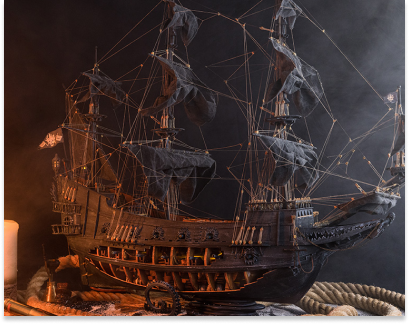What are the most famous English warships?
Within the vast, prolific, and successful naval history of the British Empire, we highlight some English warships:
- HMS Victory: A 104-gun ship. Perhaps the most famous ship of the British Navy. It was Admiral Nelson's flagship during the Battle of Trafalgar, where he lost his life, but the Royal Navy scored a decisive victory against the French and Spanish fleets.
- HMS Endeavour: Of great tonnage, it was built in the 18th century and registered as a Royal Navy ship with the mission of making exploration voyages. This great ship, part of the British fleet, circumnavigated the globe over three years under the command of the legendary Captain James Cook with the aim of calculating the distance between the Earth and the Sun based on the 'transit of Venus', which is an astronomical phenomenon in which this planet passes directly between the Earth and the Sun being visible as a small dark spot. This happens when the stars are aligned in the same orbital plane. In addition, the Endeavour was crucial in exploring extensive areas of the Pacific, including the coasts of New Zealand and the east coast of Australia.
- HMS Endurance: Evokes a great story of overcoming. This ship, which was part of the Imperial Transantarctic Expedition, became trapped in the ice of the Weddell Sea on August 19, 1915. For 522 days, they endured winds of up to 300 km/h and temperatures of 40 degrees below zero. Despite the terrible conditions, they managed to survive under the command of Sir Ernest Shackleton.
- HMS Terror & HMS Erebus: They were ships of the Lost Expedition that, in 1845, embarked on a journey into the unknown in search of the Northwest Passage, a sea route located in the Arctic that connects the Atlantic Ocean with the Pacific through the waters of northern Canada. This passage was seen as a shortcut for maritime trade between Europe and Asia. The ship was equipped with auxiliary engines, iron plates to protect it from the ice, and provisions for three years of sailing. Nevertheless, it became trapped in the labyrinthine waters of Greenland and nothing more was heard of it until 2016, when part of its remains were recovered thanks to an Inuit hunter.
- HMS Bounty: It was a ship of the British fleet whose mission was to transport breadfruit from Tahiti to the Caribbean. The breadfruit was intended to cheaply feed the slaves working on the sugar cane plantations.
- HMS Beagle: It does not fall into the category of English warships, but indirectly had a great impact on history. Charles Darwin's theory of evolution was largely developed thanks to the journey he made aboard the HMS Beagle. Darwin embarked on this exploration journey around the world in 1831 and returned to England in 1836. During his voyage, Darwin collected a considerable amount of observations and specimens of the flora and fauna of various regions, including South America, the Galápagos Islands, Australia, and Africa.
These are just a few examples of ships that have left their mark on British naval history.
English ship models to assemble
Immerse yourself in the fascinating experience of building models of British ships with our naval modeling reproductions. Dive into the brave maritime history of one of the great empires as you assemble detailed replicas of iconic vessels.
Our models offer an opportunity to accurately recreate the iconic war and exploration ships that have left a unique imprint on history. With high-quality kits, realistic details, and very clear instructions, exploring the world of English ship naval modeling is going to be a rewarding experience for enthusiasts and collectors alike. Start your construction journey today and bring British naval history to life in your home!
Characteristics of the English fleet
Throughout history, the British fleet has evolved reflecting technological advances, naval strategies, and specific needs of each era. Below, we offer some characteristics by periods:
- Galleons: the most common during the 16th and 17th centuries, in the Golden Age of Navigation
- Royal Navy consolidation in the 18th century: as one of the most powerful fleets, composed of line ships and heavy cruisers with multiple cannons
- Maritime supremacy during the 19th century: expanding its dominance and protecting trade routes. Rise of Clipper Ships, which are merchant sailboats that shortened travel times thanks to their aerodynamic design and exceptional speed.
- Modernization in the 20th century: with aircraft carriers, nuclear submarines, destroyers, and frigates. Constant adaptation to new threats and strategies.
In the context of the ships of the Invincible Armada, the light ones stood out, such as the fire ships, whose maneuverability compared to the Spanish galleons made the difference to avoid direct attacks and generate gradual wear. These tactics, combined with others such as long-range cannon attacks or refuge in dangerous waters they knew better like those of the English Channel, proved successful. The defeat of the Spanish Invincible Armada marked a milestone in 16th-century naval history, consolidating the position of the British fleet as a dominant maritime power in Europe.




























